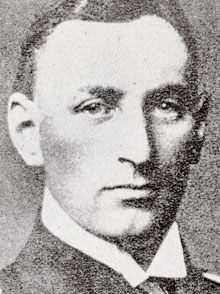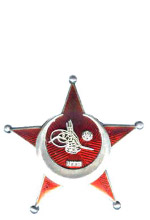Decorations
Iron Half Moon
Eiserner Halbmond
| The Ottoman War Medal (Turkish: Harp Madalyasi), better known as the Gallipoli Star, or the Iron Crescent (from German Eiserner Halbmond, in allusion to the Iron Cross) was a military decoration of the Ottoman Empire which was instituted by the Sultan Mehmed Reshad V on 1 March 1915 for gallantry in battle. This decoration was awarded for the duration of World War I to Ottoman and other Central Powers troops, primarily in Ottoman areas of engagement. The award includes a badge, ribbon and campaign bar. The medal, made of nickel-plated brass, has a vaulted star-shaped badge, 56 mm across the diagonal span of the arms. The tips of the star are capped by ball finials and enclosed in a raised silver edge with the field in red lacquer or enamel. A raised crescent, open at the top, encircles the center of the badge. Inside the crescent is the tughra or cipher of the decoration's creator, Sultan Mehmed Reshad V, over the date 1333 AH (AD 1915). The reverse is flat, unadorned and has a straight pin. Along with the badge came a ribbon with red and white stripes. The dimensions of the ribbon for combatants are: red 2.5 mm; white, 5 mm.; red, 29 mm.; white, 5 mm.; red 2.5 mm. For non-combatant awardees, the colors are reversed. The campaign bar is a right-pointing parabola of white at 56mm in length and 7mm in height. In the field is red Arabic script denoting the specific campaign: Chanakkale/Chanak (Gallipoli) Gaza Kanal Kut-al-Amara SanatoriumWhen in formal dress, the badge was worn at the center, below the right breast pocket. Wear of the badge was exclusive; in everyday wear was substituted by the ribbon. The ribbon was worn from the second hole in the tunic button. For Austrian and German awardees (usually members of the Asienkorps), the award took lower precedence to their own Iron Cross 2nd class, and the ribbon of the Iron Crescent was placed beneath that of the Iron Cross. The ribbon could also be fashioned into a chest ribband for placement on a ribbon bar when in undress. The campaign bar was usually not worn. |
| Commander | Date | Command | |||
|---|---|---|---|---|---|
| Kptlt. | Adam, Hans | 3 Jul 1916 | |||
| Kptlt. | Arnauld de la Perière, Lothar von | U 35 | |||
| Kptlt. | Canaris, Wilhelm | 2 Jul 1918 | UB 128 | ||
| Kptlt. | Carls, Rolf | 4 Jan 1917 | |||
| Oblt. | Dönitz, Karl | 7 Nov 1916 | |||
| Kptlt. | Fischel, Hermann von | 3 Oct 1918 | |||
| Kptlt. | Haecker, Erich | 1 Sep 1918 | |||
| Oblt. | Heimburg, Heino von | ||||
| Kptlt. | Hersing, Otto | 25 May 1915 | U 21 | ||
| Oblt. | Krieger, Ernst | 3 Jan 1918 | |||
| Oblt. | Kümpel, Otto | 2 Jul 1918 | UC 37 | ||
| LSL. | Leschanowsky, Lothar | 1916 or so | |||
| Oblt. | Loycke, Otto | 3 Jan 1918 | |||
| Oblt. | Marschall, Wilhelm | ||||
| Oblt. | Mellenthin, Hans von | ||||
| Kptlt. | Rücker, Claus | 3 Jan 1917 | |||
| Oblt. | Schrader, Otto von | 1 Nov 1915 | |||
| Kptlt. | Schultze, Otto | U 63 | |||
| Kptlt. | Valentiner, Max | 2 Jan 1917 | U 38 | ||
| Oblt. | Weichold, Eberhard | 2 Jul 1918 | UC 22 | ||
| Oblt. | Wurmbach, Hans Heinrich | 2 Jul 1918 | |||
21 officers decorated with Iron Half Moon (Eiserner Halbmond) located.
Note: This listing is still being compiled and some recipients might be missing.


